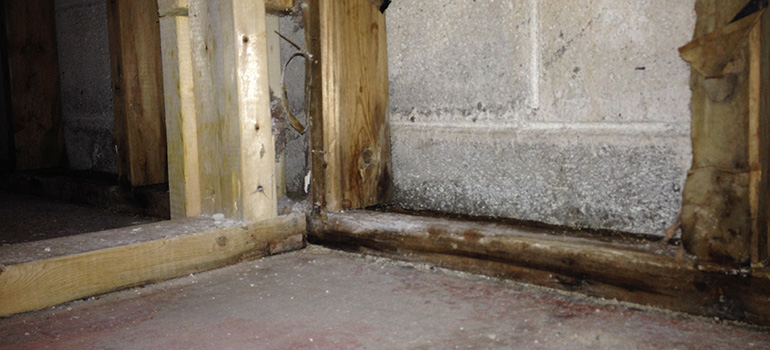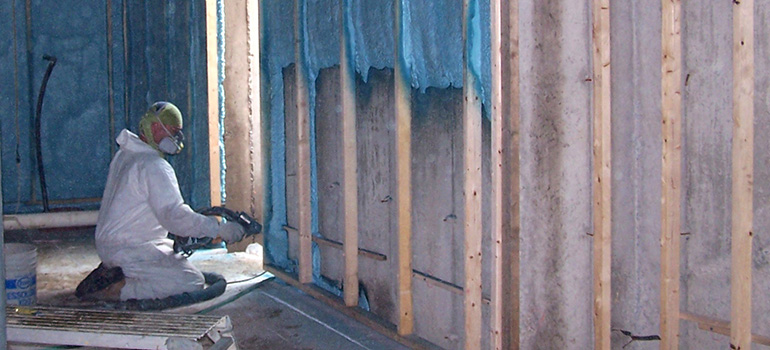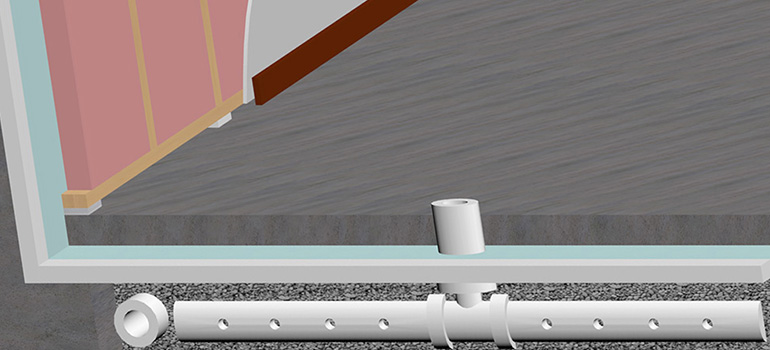
aKcdSvMHt1p/bIgDY4RVDV/U6wLa0SSns5gjFHx2qi4=_16fc3b17de2:c973b5:3a69d9ab
Preventing mold when you insulate your basement
A properly insulated basement does not have moisture or mold issues. We can help make sure your basement is mold-free!

Basements don't have to be moldy, that is the first thing to realize.
It's easy to build a basement better, or to finish an existing basement correctly, we just need to realize that they behave differently than above grade walls and to build accordingly to effectively deal with the humidity found underground - and by doing so, stop the conditions that promote mold growth.
Depending on the age of your home, you may have some interior basement insulation or maybe none. You may have an exterior damp-proofing spray on foundation walls but likely not a proper drainage mat and perimiter drain.
Outside upgrades are the ideal correction given the way basement walls were left exposed in the past; however, unless you have serious structural problems or plan to excavate for other reasons, that can be an enormous extra cost for an interior renovation project. It is much more affordable to deal with most humidity issues inside the building. The basement insulation solutions proposed here are for those that have no exterior protection.
What causes mold to grow in basements?
Mold can grow on virtually any organic material as long as the moisture levels it likes and oxygen are present.
Because mold eats or digests what it is growing on, it can damage a building and its furnishings. If left unchecked, mold eventually can cause structural damage to building materials and can cause health problems - that's why we don't want mold in our basements!
Specifically, we can prevent damage to buildings and building contents in the basement areas, save money and avoid these potential health problems by controlling moisture, where humidity in the air condenses, and by so eliminating mold growth.
Quick Fact Check: Eliminating all mold and mold spores indoors is virtually impossible, but controlling indoor moisture and the hidden moisture within basement wall assemblies will control the growth of indoor mold.
According to the EPA, indoor relative humidity (RH) in homes should be kept below 60 percent - ideally between 30 percent and 50 percent, In addition to preventing mold forming, maintaining the correct humidity levels may also have a bonus effect - discouraging pests such as cockroaches, silverfish (bristletails) and dust mites from populating the man-cave!
Where the moisture is, and where it wants to go:
The key to building better mold-free basements is to understand that there is a completely different set of challenges facing walls built below grade.
The greatest source of moisture to contend with above grade is the warm, humid air generated by cooking, washing and simply breathing. Below grade, it is that big porous sponge called concrete that is sucking up water from the wet ground.
A different problem demands a different solution - wearing a raincoat will keep you dry when standing in a cold rain, but it won't keep you dry when jogging under a hot sun. And unfortunately for many homeowners, the way basements were finished for the last few decades is about as logical as jogging in a raincoat.
Above grade, walls are designed to dry to the exterior. That is impossible below grade, but for some reason we still build as if it were. Despite the fact that interior vapour barriers in below grade wall assemblies are commonplace, frustrated building scientists insist that installing them is the worst thing you could possibly do down there.

Above is a photo of a basement being repaired after flooding. The mold damage you see is from longterm moisture exposure, not the one-time flooding event. This was a typical basement wall assembly, with a stud wall directly against the foundation followed by fiberglass insulation and a vapour barrier. Notice the difference between the studs against the foundation and the studs that formed an interior division wall; the vapour barrier did not protect the exterior wall from damage and mold growth. It caused the damage by prevented the wall from drying to the interior and instead sealed the moisture in.
As one of the foremost authorities on healthy basement construction, Professor John Straube of the University of Waterloo dubbed this typical type of wall assembly a "mold incubation chamber". For further convincing on the topic, read 'Built wrong from the start' by Joseph Lstiburek of Building Science Corporation.
Better basement insulation techniques:
The materials and design you choose are very important to prevent mold and should be appropriate for the environment they are destined to inhabit. Be very careful how and where you install wood and fiberglass insulation in basements (If you must), and be sure they won't see prolonged exposure to moisture or contact with humid surfaces if you don't want them to go moldy.
Spray polyurethane foam (SPUF):
When SPUF works out, it can be one of the better performing products in basement applications. Being sprayed directly onto concrete walls, it ensures even and total protection. SPUF has a high R-value per inch, acts as an air barrier and a vapor barrier. However, it has been known to shrink after application, leaving air gaps and a lack of thermal protection.
Another downside to the original SPUF is that some blowing agents have a high global warming potential (GWP). For this reason, we like to explore less harmful alternatives whenever possible - though *January 2018 update: new blowing agents for spray foam virtually eliminate green house gases.
Probably the most worrisome problem (as reported by a SPUF installer) is that there is a great temptation for installation contractors to tinker with the chemical mix a bit, giving it more volume with less material, which is more profitable for the installers. There are not a lot of reported cases of this, but when it goes wrong it goes very wrong. Personally, I wouldn't let someone spray foam in my house without some pretty good references that I followed up.
All that said, here's how to proceed if you plan to insulate a basement with SPUF:
- Frame a 2x4 stud wall at 24" centres leaving a gap of at least one inch between studs and concrete.
- Shim up bottom plates to allow for water to pass under in cases of mild flooding.
- Has foam sprayed against the concrete wall? The space left between concrete and studs is crucial to allow a seamless blanket of insulation to create an air and vapor barrier. Unprotected wood touching concrete will wick moisture and eventually rot. One inch of SPUF will solve your problems; four or 5 inches will reduce heat loss and save you money in the long run.
- Has insulation blown onto rim joists if it isn't already done?
- The foam must be covered by drywall for fire protection.
- Don't install an additional vapor barrier behind drywall; latex paint will act in this capacity.

There have been a few nightmare cases reported where a SPUF installation went very wrong and apparently made homes uninhabitable. Given the fact that the application involves a wet spray that hardens on surfaces, it is very difficult to remove.
These reported cases are rare, but if you are at all concerned, there are alternatives to spray foam for insulating basements listed below that work well in the battle against moldy basements.
EPS (Expanded Polystyrene), XPS (Extruded Polystyrene), Mineral wool:
SPUF is quite expensive; so rigid insulation panels and a 2x4 wall with batt insulation can be a much more affordable option - but you need to know the right techniques for a successful and mold-free wall assembly for a basement application - read on!
Rigid insulation board against concrete adds R-value, breaks the thermal bridge and raises the temperature of the stud wall, which helps prevent moist air from condensing. The stud wall allows for the installation of wiring, additional insulation and drywall.
Drywall should be attached directly to studs, latex paint will act as a vapor retarder slowing any outward moisture migration while also allowing walls to dry inwards.
You may hear that EPS is somewhat moisture-permeable; this is true, but only slightly so and not enough to be a problem. According to Professor Straube, two inches of EPS has a perm rating in the range of 60-75 ng, or 1-1.25 US perms, which is right on the cusp of what is defined by building code as a suitable vapor barrier (60ng and under).
At that level of moisture permeability, an almost immeasurably small amount of moisture will be able to migrate into the wall, but with no interior vapor barrier it will pass through harmlessly. EPS, XPS and mineral wool are unharmed by moisture, and perhaps most importantly, EPS and XPS are unlikely to provide a breeding ground for mold.
A polyethelene barrier can be included without causing harm (as seen below), as long as it is behind the stud wall, not in front. Specified correctly for basement Radon Mitigation, this will also act as a radon gas barrier to protect indoor air quality, and it will satisfy building inspectors who are not accustomed to seeing a wall without a vapour barrier and may not allow you to continue.

Note: the above diagram shows an ideal and complete basement renovation beginning with breaking and removing the existing concrete floor. Most older basements have very limited head room and owners are often reluctant to lower it even more by adding insulation to the floor. It also allows for the addition of a radon evacuation stack, which is the perforated tube and T-junction in this image.
By removing the concrete floor and maybe some of the dirt below it, you have room to insulate properly. Removing existing concrete is not as tough as it sounds - it can usually be smashed with a sledge hammer and removed in pieces. It does involve some hard work and heavy lifting, but the end result will not only be a more efficient and comfortable home, but a more valuable one at a time of resale and less likely to create the conditions that are best avoided - high humidity plus likely condensation points - both factors in producing a moldy, unhealthy basement.
The ideal Basement wall assembly to prevent mold growth:
- Install two inches of rigid insulation board directly against concrete. It is easiest to attach it to the wall with a couple of concrete nails or even some adhesive while you frame walls.
- Frame an interior 2x4 stud wall at 24-inch centers, pressed tightly against the foam panels.
- Install mineral wool batts in the cavities. Mineral wool is unharmed by moisture, and if it gets wet it will retain its shape and R-value when it dries; fiberglass is not so resilient.
- Lastly, install drywall and paint it with latex paint only.
This technique of rigid and batt insulation may require a few more steps, but it can offer you a greater R-value per dollar invested than SPUF and it allows you to do a lot more (or all) of the work yourself.
For reasons beyond just performance, we prefer mineral wool or EPS over XPS. XPS has a slightly higher R-value per inch, but like SPUF, the blowing agents are exponentially more harmful, about 200 times more than EPS.
What else helps prevent mold from growing in basements? Ventilation!
Another considerable improvement in keeping basements mold-free is to ensure adequate ventilation. Whilst cracking open a window if your basement has them is fine if the humidity conditions outside are favorable, that's pretty hard to judge; so a better alternative is to choose a good quality discounted HRV or ERV system with automatic electronic humidity control.
Along with removing contaminants from the air, there are health consequences from having either too much or too little moisture in our homes. There are bacteria, viruses, molds and mites that will show up on either end of the spectrum if your air is either too humid or too dry.
As the EPA say, somewhere in the range of 35 to 50% relative humidity is generally assumed to be the best for avoiding most health risks and irritants. It’s high enough that you won’t have cracked furniture, chapped lips or constant nose bleeds, and it’s not too damp for comfort, condensation or heat consumption issues.
If you're in an older home sat above a basement, don’t panic. What we write in these pages is meant to inspire ideas and solutions, not fear and anxiety. If you feel good, your basement smells good and your windows (and walls) aren’t dripping, relax!
However, if your basement has a certain musty smell or telltale black mildew and mold marks in corners or behind furniture, for peace of mind consider buying a hydrometer to measure your indoor relative humidity, which will cost you maybe $20 to $30 at most hardware stores. If you have an issue, and the humidity levels are off the scale, then chances are you've got a moldy basement even if you can't see it yet.